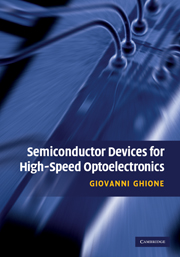Preface
Published online by Cambridge University Press: 03 February 2010
Summary
The development of high-speed fiber-based optical communication systems that has taken place since the early 1970s can be really considered as a technological wonder. In a few years, key components were devised (such as the semiconductor laser) with the help of novel technological processes (such as epitaxial growth) and found immediate application thanks to the development of low-loss optical fibers. New compound semiconductor alloys (namely, InGaAsP) were ready to provide their potential to emit the right wavelengths needed for long-haul fiber propagation. When electronic repeaters seemed unable to provide a solution to long-haul propagation, fiber amplifiers were developed that allowed for all-optical signal regeneration. And the list could be continued. A miracle of ingenuity from a host of researchers made it possible to assemble this complex puzzle in a few years, thus bringing optoelectronic technology to a consumer electronics level.
Increasing the system capacity by increasing the transmission speed was, of course, a main concern from the early stages of optical system development. While optoelectronic devices behave, on the electronic side, in a rather conventional way up to speeds of the order of 1 Gbps, for larger speeds (up to 40 Gbps and beyond) RF wave propagation has to be accounted for in designing and modeling optoelectronic devices. When speed increases, the distributed interaction between RF and optical waves becomes a useful, sometimes indispensable, ingredient in many optoelectronic devices, like modulators and (to a lesser extent) detectors. Similarly, the electronic circuits that interface light sources, modulators, and detectors should provide broadband operation up to microwave or millimeter-wave frequencies, thus making it mandatory to exploit compound semiconductor electronics (GaAs- or InP-based) or advanced Si-based solutions (like SiGe HBT integrated circuits or nanometer MOS processes).
- Type
- Chapter
- Information
- Semiconductor Devices for High-Speed Optoelectronics , pp. xiii - xviPublisher: Cambridge University PressPrint publication year: 2009



